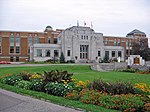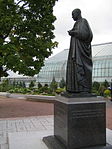Montreal Insectarium

The Montreal Insectarium (French: Insectarium de Montréal) is a natural history museum located in Montreal, Quebec, Canada, featuring a large quantity of insects from all around the world. It is the largest insect museum in North America and among the largest insectariums worldwide. It was founded by Georges Brossard and opened on February 7, 1990. Its average attendance is 400,000 visitors per year. It displays both live and dead insect collections, from butterflies to bees and ants. It is one of the city's most popular tourist attractions, along with the Montreal Botanical Garden, Montreal Planetarium and the Montreal Biodome. Seen from the sky, the Montréal Insectarium resembles a stylized insect. This can also be seen from the observatory of Montréal's Olympic Stadium.
Excerpt from the Wikipedia article Montreal Insectarium (License: CC BY-SA 3.0, Authors, Images).Montreal Insectarium
Rue Sherbrooke Est, Montreal Rosemont–La Petite-Patrie
Geographical coordinates (GPS) Address External links Nearby Places Show on map
Geographical coordinates (GPS)
| Latitude | Longitude |
|---|---|
| N 45.560833333333 ° | E -73.557777777778 ° |
Address
Insectarium
Rue Sherbrooke Est
H1V 0B2 Montreal, Rosemont–La Petite-Patrie
Quebec, Canada
Open on Google Maps









